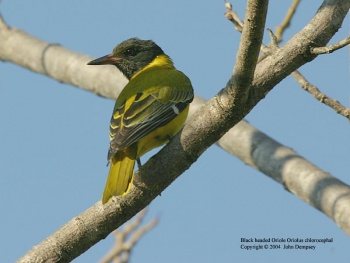(Picture of Immature bird. Distribution & Taxonomy expanded. Some deleted text replaced) |
|||
| Line 1: | Line 1: | ||
| − | [[Image:African_Black-headed_Oriole.jpg|thumb|445px|right|Photo by {{user|safariranger|safariranger}}<br /> | + | [[Image:African_Black-headed_Oriole.jpg|thumb|445px|right|Photo by {{user|safariranger|safariranger}}<br />[[Kruger National Park]], [[South Africa]]]] |
'''Alternative name: Eastern Black-headed Oriole''' | '''Alternative name: Eastern Black-headed Oriole''' | ||
;[[:Category:Oriolus|Oriolus]] larvatus | ;[[:Category:Oriolus|Oriolus]] larvatus | ||
| Line 5: | Line 5: | ||
Bright yellow body, black head, olive central tail feathers, yellowish edge of its inner secondaries, flesh-coloured beak. | Bright yellow body, black head, olive central tail feathers, yellowish edge of its inner secondaries, flesh-coloured beak. | ||
====Similar Species==== | ====Similar Species==== | ||
| − | + | It can be distinguished from other similar species (eg the [[Western Black-headed Oriole]] or the [[Montane Oriole]]) by its olive central tail feathers and the yellowish edge of its inner secondaries.<br /> | |
| + | Where it is conspecific with other black-headed Orioles it tends to be restricted to the forest edge. | ||
==Distribution== | ==Distribution== | ||
| − | Sub-Saharan [[Africa]] | + | Sub-Saharan [[Africa]]:<br /> |
| + | '''Western Africa''': [[Equatorial Guinea]], [[Democratic Republic of Congo]], [[Angola]]<br /> | ||
| + | '''Eastern Africa''': [[Sudan]], [[Ethiopia]], [[Somalia]], [[Kenya]], [[Uganda]], [[Rwanda]], [[Burundi]], [[Tanzania]], [[Zambia]], [[Mozambique]], [[Malawi]]<br /> | ||
| + | '''Southern Africa''': [[Namibia]], [[Botswana]], [[Zimbabwe]], [[South Africa]], [[KwaZulu-Natal]], [[Lesotho]], [[Swaziland]] | ||
| + | [[Image:267Black headed Oriole copy.jpg|thumb|350px|right|Non-breeding first year bird; the bill has not quite reached the red stage and the hood is not totally dark <br />Photo by {{user|jdbirdman|jdbirdman}}<br />Oribi Gorge, [[South Africa]], August 2004]] | ||
==Taxonomy== | ==Taxonomy== | ||
''Oriolus larvatus'' has six subspecies:<sup>[[#References|1]]</sup> | ''Oriolus larvatus'' has six subspecies:<sup>[[#References|1]]</sup> | ||
| − | *''O. l. angolensis'' | + | *''O. l. angolensis'': |
| − | *''O. l. additus'' | + | :*[[Angola]] to [[Namibia]] and [[Zambia]] |
| − | *''O. l. tibicen'' | + | *''O. l. additus'': |
| − | *''O. l. reichenowi'' | + | :*South-eastern [[Tanzania]] and [[Mozambique]] |
| − | *''O. l. rolleti'' | + | *''O. l. tibicen'': |
| − | *''O. l. larvatus'' | + | :*Coastal southern [[Tanzania]] to southern [[Mozambique]] |
| + | *''O. l. reichenowi'': | ||
| + | :*Coastal southern [[Somalia]] to central [[Tanzania]] | ||
| + | *''O. l. rolleti'': | ||
| + | :*[[Ethiopia]], [[Sudan]], [[Uganda]], [[Rwanda]], [[Burundi]] (?) and eastern [[Zaire]] | ||
| + | *''O. l. larvatus'': | ||
| + | :*Eastern [[South Africa]], [[Mozambique]] and southern [[Zimbabwe]] | ||
==Habitat== | ==Habitat== | ||
Inhabits ''Acacia'' woodland and other types of open woodland as well as being seen in mangroves and forest. | Inhabits ''Acacia'' woodland and other types of open woodland as well as being seen in mangroves and forest. | ||
| Line 21: | Line 32: | ||
The diet includes small fruit as well as large insects. The young are fed mostly with caterpillars. | The diet includes small fruit as well as large insects. The young are fed mostly with caterpillars. | ||
==References== | ==References== | ||
| − | #{{Ref- | + | #{{Ref-Clements6thDec08}}#Avibase |
{{Ref}} | {{Ref}} | ||
==External Links== | ==External Links== | ||
{{GSearch|Oriolus+larvatus}} | {{GSearch|Oriolus+larvatus}} | ||
[[Category:Birds]][[Category:Oriolus]] | [[Category:Birds]][[Category:Oriolus]] | ||
Revision as of 14:16, 4 June 2009
Alternative name: Eastern Black-headed Oriole
- Oriolus larvatus
Identification
Bright yellow body, black head, olive central tail feathers, yellowish edge of its inner secondaries, flesh-coloured beak.
Similar Species
It can be distinguished from other similar species (eg the Western Black-headed Oriole or the Montane Oriole) by its olive central tail feathers and the yellowish edge of its inner secondaries.
Where it is conspecific with other black-headed Orioles it tends to be restricted to the forest edge.
Distribution
Sub-Saharan Africa:
Western Africa: Equatorial Guinea, Democratic Republic of Congo, Angola
Eastern Africa: Sudan, Ethiopia, Somalia, Kenya, Uganda, Rwanda, Burundi, Tanzania, Zambia, Mozambique, Malawi
Southern Africa: Namibia, Botswana, Zimbabwe, South Africa, KwaZulu-Natal, Lesotho, Swaziland

Photo by jdbirdman
Oribi Gorge, South Africa, August 2004
Taxonomy
Oriolus larvatus has six subspecies:1
- O. l. angolensis:
- O. l. additus:
- South-eastern Tanzania and Mozambique
- O. l. tibicen:
- Coastal southern Tanzania to southern Mozambique
- O. l. reichenowi:
- O. l. rolleti:
- O. l. larvatus:
- Eastern South Africa, Mozambique and southern Zimbabwe
Habitat
Inhabits Acacia woodland and other types of open woodland as well as being seen in mangroves and forest.
Behaviour
The diet includes small fruit as well as large insects. The young are fed mostly with caterpillars.
References
- Clements, JF. 2008. The Clements Checklist of Birds of the World. 6th ed., with updates to December 2008. Ithaca: Cornell Univ. Press. ISBN 978-0801445019.
- Avibase
Recommended Citation
- BirdForum Opus contributors. (2025) African Black-headed Oriole. In: BirdForum, the forum for wild birds and birding. Retrieved 30 April 2025 from https://www.birdforum.net/opus/African_Black-headed_Oriole




